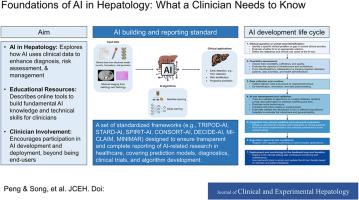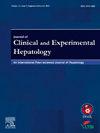Foundations of Artificial Intelligence in Hepatology: What a Clinician Needs to Know
IF 3.2
Q2 GASTROENTEROLOGY & HEPATOLOGY
Journal of Clinical and Experimental Hepatology
Pub Date : 2025-09-05
DOI:10.1016/j.jceh.2025.103183
引用次数: 0
Abstract
This review focuses on foundational knowledge about artificial intelligence (AI) in hepatology, exploring how AI, including machine learning and deep learning, leverages large-scale clinical data to transform the diagnosis, risk assessment, prognostication, and management of liver diseases. Online resources are described to offer fundamental AI knowledge and essential technical skills and to facilitate clinician participation across the entire AI lifecycle, ensuring they contribute not only as end users but also in development and deployment. Unlike traditional statistical approaches that prioritize interpretable parameters and clinical insight, AI focuses on maximizing predictive accuracy by identifying complex, often non-linear patterns using high-dimensional data, albeit often at the cost of model interpretability. AI is demonstrating clinical utility in liver histopathology and radiological imaging, significantly improving detection accuracy for cirrhosis, clinically significant portal hypertension, and hepatocellular carcinoma. Beyond diagnostics, AI-driven prediction models are emerging to provide personalized risk stratification for the development of liver-related complications and treatment guidance, based on complex data including longitudinal laboratory results, comorbidities, and co-medication use to monitor disease progression and therapy response. The field is rapidly expanding into novel areas such as analyzing patient-reported outcomes, genomic data, and real-time liver function monitoring, offering deeper mechanistic insights alongside clinical tools. Despite the potential to revolutionize hepatology practice and research, successful integration into routine care faces challenges. These include seamless workflow integration with existing electronic health records, establishing clear liability frameworks, and guaranteeing protection of patient privacy. Addressing these hurdles requires collaborative efforts from clinicians, researchers, and regulators to develop best practices and governance. Understanding the transformative capabilities, current applications, emerging frontiers, and essential implementation considerations is crucial for clinicians navigating the evolving AI landscape and responsibly utilizing its power for improved patient outcomes.

肝病学人工智能的基础:临床医生需要知道什么
本文综述了人工智能(AI)在肝病学中的基础知识,探讨了包括机器学习和深度学习在内的人工智能如何利用大规模临床数据来改变肝脏疾病的诊断、风险评估、预后和管理。在线资源被描述为提供基本的人工智能知识和基本的技术技能,并促进临床医生在整个人工智能生命周期中的参与,确保他们不仅作为最终用户,而且在开发和部署中做出贡献。与优先考虑可解释参数和临床洞察力的传统统计方法不同,人工智能侧重于通过使用高维数据识别复杂的、通常是非线性的模式来最大限度地提高预测准确性,尽管通常以模型可解释性为代价。人工智能在肝脏组织病理学和放射学成像方面的临床应用,显著提高了肝硬化、临床表现明显的门脉高压和肝细胞癌的检测准确性。除了诊断,人工智能驱动的预测模型正在兴起,为肝脏相关并发症的发展提供个性化的风险分层和治疗指导,基于复杂的数据,包括纵向实验室结果、合并症和联合用药,以监测疾病进展和治疗反应。该领域正在迅速扩展到新的领域,如分析患者报告的结果、基因组数据和实时肝功能监测,为临床工具提供更深入的机制见解。尽管有可能彻底改变肝病学实践和研究,但成功融入常规护理面临挑战。这些措施包括与现有电子健康记录无缝集成工作流程、建立明确的责任框架以及确保保护患者隐私。解决这些障碍需要临床医生、研究人员和监管机构共同努力,以制定最佳实践和治理。了解变革能力、当前应用、新兴领域和基本实施考虑因素对于临床医生驾驭不断发展的人工智能环境并负责任地利用其力量改善患者预后至关重要。
本文章由计算机程序翻译,如有差异,请以英文原文为准。
求助全文
约1分钟内获得全文
求助全文
来源期刊

Journal of Clinical and Experimental Hepatology
GASTROENTEROLOGY & HEPATOLOGY-
CiteScore
4.90
自引率
16.70%
发文量
537
审稿时长
64 days
 求助内容:
求助内容: 应助结果提醒方式:
应助结果提醒方式:


